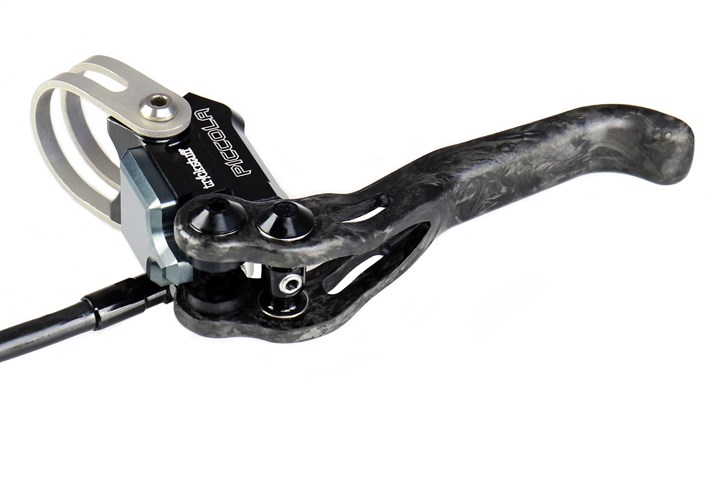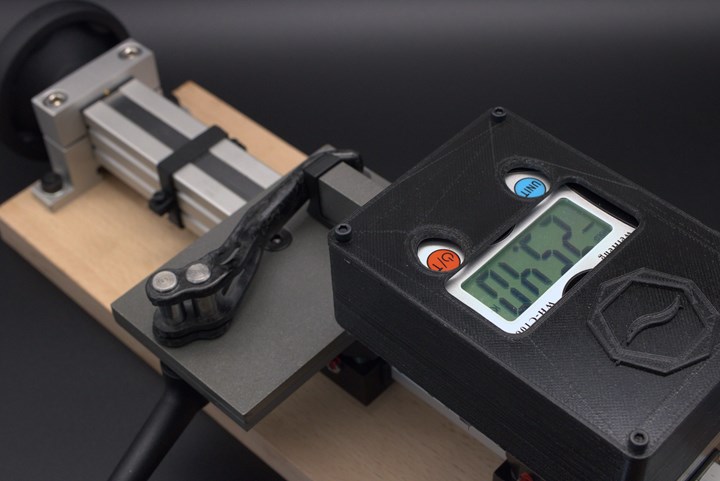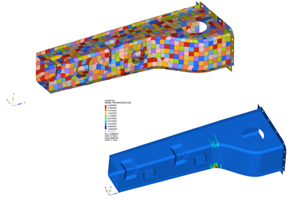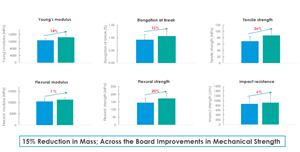
Premium composite brake levers designed by carbon fiber SMC specialist Blackwave are now available on Piccola series bicycles. Source, all images | Blackwave GmbH
“A carbon frame is almost standard on a good bike, but few people dare to build a carbon brake lever,” says Timon Strube, chief operating officer at Blackwave GmbH (Taufkirchen, Germany). In partnership with bike part supplier Trickstuff (Freiburg, Germany), Blackwave recently designed a premium brake lever manufactured with carbon fiber sheet molding compound (SMC) that is said to save weight by 35% compared to the previous aluminum version.
Blackwave is fairly new to the sporting goods market, but not to carbon fiber SMC. The company was founded in 2016 by former college classmates Bastian Behrens, CEO, and Raphael Setz, chief technical officer, with a focus on specialty automotive components built from carbon fiber SMC. Behrens and Setz first met at the Technical University of Munich (TUM), where they successfully built carbon fiber SMC car rims for their school’s Formula Student vehicle design and engineering team. The vehicle, Behrens says, was highly successful in the collegiate competition, ranking third in the world in 2013. Those SMC rims would serve as inspiration for the partners’ new company.

Blackwave operates a series of Langzauner hydraulic presses, producing carbon fiber SMC parts out of its facility in Taufkirchen, Germany.
The next four years saw Blackwave expand into a larger facility in 2018, finish its first large-volume order for Porsche in 2019 and close a new seven-digit round of funding at the beginning of 2020. Now, according to Behrens, Blackwave is expanding its specialty services in small, complex carbon fiber SMC part fabrication into new markets such as sporting goods applications.
The brake lever project began in summer 2019, when Blackwave first met representatives from Trickstuff at the Riva Bike Festival in Riva del Garda, Italy. Trickstuff is said to be developing the lightest, strongest disc brake in the world — called the Piccola series — and approached Blackwave about developing a carbon fiber SMC brake lever as part of the project.
To design the part, Blackwave had to rethink the brake lever geometry to meet mechanical requirements using the new material. Finite element analysis (FEM) was used to identify highly stressed areas of the part, informing decisions about fiber orientation in different parts of the lever. After a few iterations and additional testing, the final part features a mostly unidirectional (UD) fiber orientation for the tension and compression strut, with a circular fiber orientation around the bearing set. According to Blackwave, the new brake lever, weighing in at 7 grams, falls into the lightweight range and can also withstand a lever force of at least 300 Newtons.
To build the brake lever, Blackwave cuts the Astar (Sondika, Spain) carbon fiber SMC material to the correct shape using a CNC cutting machine. The preforms are inserted and molded using a Langzauner (Lambrechten, Austria) hydraulic press system. Once ejected, the parts are trimmed and milled using Hufschmied (Bobingen, Germany) milling bits/equipment. In the final steps, the maximum force is tested and the surface gets finished.

Blackwave tests parts in-house to make sure they meet force requirements.
“We're doing everything from concept up to ready-to-assemble parts. This is necessary, because most of our customers have never even heard about carbon-SMC. So we take our customers by the hand from the very beginning,” Behrens says.
After successful endurance and maximum force testing of the brake levers last winter, Blackwave began series production of the parts, and today, every disc brake of the Piccola series is delivered with a composite brake lever.
According to Behrens, Blackwave continues to expand its business into other sporting goods applications, as well as complex parts for the space, aviation and medical industries. The company also reports that it has recently launched its largest series so far, consisting of 30,000 components for the automotive industry.
Related Content
Co-molding SMC with braided glass fiber demonstrates truck bed potential
Prepreg co-molding compound by IDI Composites International and A&P Technology enables new geometries and levels of strength and resiliency for automotive, mobility.
Read MoreSMC simulation tool enhances design optimization
CAMX 2023: FiRMA, Engenuity’s new approach to SMC, uses a predictive technique that accurately reflects material properties and determine the performance range an SMC part or structure will exhibit.
Read MoreDieffenbacher acquires Schmidt & Heinzmann composites business
The acquisition, which includes all intangible assets of the business unit, will expand Dieffenbacher’s SMC delivery spectrum, enable potential for portfolio growth and synergies.
Read MoreGraphene-enhanced SMC boosts molded component properties
CAMX 2023: Commercially sold GrapheneBlack SMC from NanoXplore increases part strength, stiffness and provides other benefits for transportation, renewable energy, energy storage and industrial markets.
Read MoreRead Next
VIDEO: High-volume processing for fiberglass components
Cannon Ergos, a company specializing in high-ton presses and equipment for composites fabrication and plastics processing, displayed automotive and industrial components at CAMX 2024.
Read MoreAll-recycled, needle-punched nonwoven CFRP slashes carbon footprint of Formula 2 seat
Dallara and Tenowo collaborate to produce a race-ready Formula 2 seat using recycled carbon fiber, reducing CO2 emissions by 97.5% compared to virgin materials.
Read MoreDeveloping bonded composite repair for ships, offshore units
Bureau Veritas and industry partners issue guidelines and pave the way for certification via StrengthBond Offshore project.
Read More

.jpg;width=70;height=70;mode=crop)




















